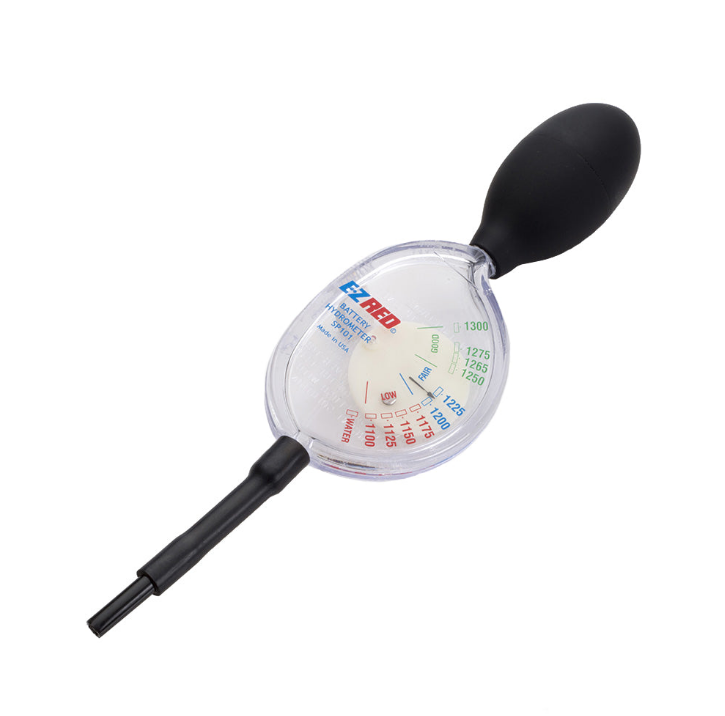How to Use a Battery Hydrometer (Never Insert a Metal Thermometer into a Battery!)


A battery hydrometer is used to test the state of charge of a battery cell. This is performed by measuring the density of the electrolyte, which is accomplished by measuring the specific gravity of the electrolyte. The greater the concentration of sulfuric acid, the more dense the electrolyte becomes. The higher the density, the higher the state of charge.
Specific gravity is the measurement of a liquid that is compared to a baseline. The baseline is water which is assigned a base number of 1.000. The concentration of sulfuric acid to water in a new golf car battery is 1.280 which means that the electrolyte weighs 1.280 times the weight of the same volume of water. A fully charged battery will test at 1.275 - 1.280 while a discharged battery will read in the 1.140 range.
! NOTE !
Do not perform a battery hydrometer test on a battery that has just been watered. The battery must go through at least one charge and discharge cycle in order to permit the water to adequately mix with the electrolyte.
The temperature of the the hydrometer reading must be corrected to 80° F (27°C). It is important to recognize that the electrolyte temperature is significantly different from the ambient temperature if the vehicle has been operated.
Hydrometer Testing Procedure: Warning! Batteries Contain Sulfuric Acid
Always Use Personal Protective Equipment from Contact with Sulfuric Acid
Eye Protection. Rubber Gloves. Rubber Apron. Closed Toe Shoes.
Avoid Wearing Any Cotton Material as Battery Acid will Dissolve Fabric
1. Draw electrolyte into the hydrometer several times to permit the thermometer to adjust to the electrolyte temperature and note the reading. Examine the color of the electrolyte. A brown or gray coloration indicates a problem with the battery and is a sign that the battery is nearing the end of its life.
2. Draw a full sample of electrolyte into the hydrometer to permit the float to float freely.
3. Hold the hydrometer in a vertical position at eye level and note the reading where the electrolyte meets the scale on the float.
4. Add or subtract four points (.004) to the reading for every 10° F (6° C) the electrolyte temperature is above or below 80° F (27° C). Adjust the reading to conform with the electrolyte temperature, e.g., if the reading indicates a specific gravity of 1.250 and the electrolyte temperature is 90° F (32° C), the 1.250 which gives a corrected reading of 1.254. Similarly if the temperature was 70° F (21° C), subtract reading of 1.246.four points (.004) from the 1.250 to give a corrected
- 5. Test each cell and note the readings (corrected to 80° F or 27° C). A variation of fifty points between any two cell readings (example 1.250 - 1.200) indicates a problem with the low reading cell(s).
- 12.60 to 12.74 = 85 to 100% Charged
- 12.40 to 12.59 = 75 to 85% Charged
- 12.20 to 12.39 = 50 to 75% Charged
- 12.00 to 12.19 = 25 to 50% Charged
- 12.00 & Below = Fully Discharged
As a battery ages the specific gravity of the electrolyte will decrease at full charge. This is not a reason to replace the battery providing all cells are within fifty points of each other.
Since the hydrometer test is in response to a vehicle exhibiting a performance problem, the vehicle should be recharged and the test repeated. If the results indicate a weak cell, the battery or batteries should be removed and replaced with a good battery of the same brand, type and approximate age.

